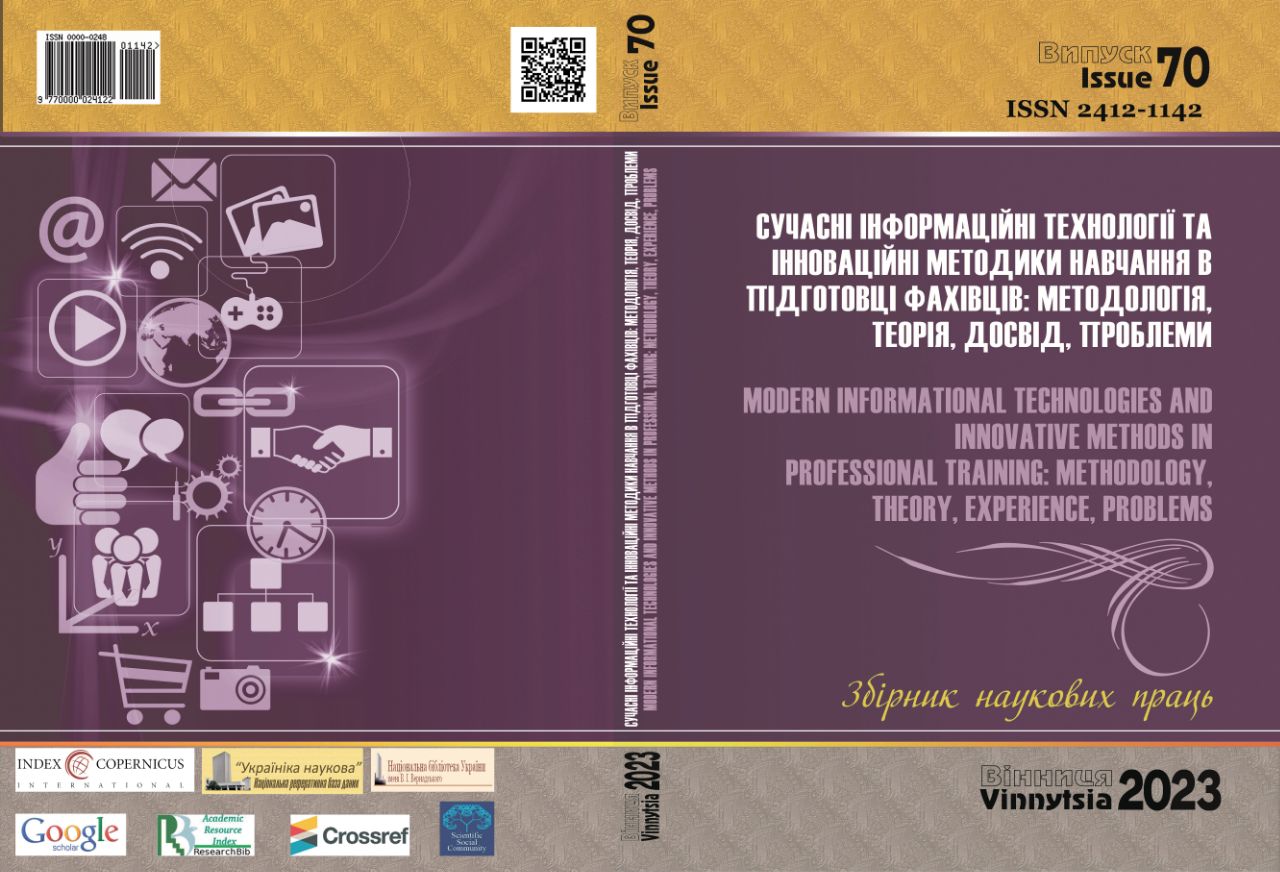USING THE GEOGEBRA ENVIRONMENT IN THE MATHEMATICAL TRAININGOF ECONOMIC STUDENTS
DOI:
https://doi.org/10.31652/2412-1142-2023-70-24-34Keywords:
mathematical training of specialists, Geogebra, information and communication technologies, teaching methodsAbstract
The use of information technology in the learning process has of learning in institutions of higher education already become commonplace, but new tools that constantly help teachers and students. In order for education to really meet the demand of modern realities, it is necessary to continuously modernize the forms and methods of education. One such most relevant assistant in teaching mathematics is the Dynamic Mathematics System GeoGebra. The article deals with the issue of modernization of methodological systems for teaching mathematical disciplines studied by students of economic specialties. in IT areas. The possibilities of the GeoGebra tool are revealed, which are important for improving the quality of mathematical training of future economists in the context of the implementation of the didactic principle of visibility and the inclusion of students in research and project activities. Particular attention is paid to the practical aspects of using GeoGebra in solving plot, applied problems associated with the use of active techniques and methods of teaching mathematical disciplines, the growth of students’ creative and intellectual activity when working with topics that require visualization of mathematical concepts and objects. The conditions of methodologically expedient inclusion of Geogebra into the practice of teaching mathematical disciplines for the preparation of economists and the modernization of already existing methodological systems for teaching mathematical disciplines are highlighted. It has been proven that the use of the interactive geometric environment GeoGebra allows visualization of abstract mathematical concepts, which contributes to the fastest possible perception of the material, a deeper understanding of it and increases interest in the discipline being studied. In addition, the use of dynamic mathematics systems both in the classroom and in non-classroom work has a positive effect on the success of students. Completing mathematical tasks using the GeoGebra environment arouses students' cognitive interest in exact sciences and promotes the development of visual and creative thinking. GeoGebra should be considered a special visual environment not only for solving specific problems related to mathematics and mathematical modeling, but also an environment for the implementation of interdisciplinary projects of an integration nature.
Downloads
References
Гриб’юк О.О., Оліда І.Я., Юнчик В.Л. (2016). Використання системи динамічної математики GEOGEBRA в процесі навчання математичних дисциплін. Освітні горизонти. Інформаційно-методичний вісник, 74, 508-514.
Семеніхіна О.В., Друшляк М.Г. (2014). Візуалізація експериментальних випробувань на основі випадкових подій у середовищі GeoGebra. Науковий часопис імені НПУ М.П. Драгоманова. Серія 3. Фізика і математика у вищій і середній школі, 14, 94-103.
Radović S. (2013). Teaching Materials «Surface Area of Geometric Figures» Created Using the Software Package GeoGebra. European Journal of Contemporary Education, 4(2), 72-80. URL: https://www.elibrary. ru/item.asp?id=19406232 (дата звернення: 15.09.2023).
Ракута В.М. (2012). Система динамічної математики GeoGebra як інноваційний засіб для вивчення математики. Інформаційні технології і засоби навчання, 4(30). URL: http://journal.iitta.gov.ua/index.php/itlt/article/view/700/524#.VVzCkvntnZE (дата звернення: 23.09.2023).
Друшляк М.Г. Лукашова Т.Д., Скасків Л.В. (2019). Навчання майбутніх вчителів математики розв’язувати задачі теорії графів із використанням GeoGebra. Фізико-математична освіта, 1, 35-40.
Horzum T., Ünlü M. (2017). Pre-Service Mathematics Teachers’ Views about GeoGebra and Its Use. Acta Didactica Napocensia. 10(3). 77-89. URL: http://padi.psiedu.ubbcluj.ro/ adn/article_10_3_8.pdf (дата звернення: 09.09.2023).
Івашко Л.М. (2012). Використання інформаційно-комунікаційних технологій для оцінювання компетенцій при підготовці економістів. Вісник соціально-економічних досліджень, 44 (1), 196-201.
Акуленко К.Ю. (2011). Підготовка майбутніх економістів з використанням засобів інформаційних технологій. Комп’ютерно-інтегровані технології: освіта, наука, виробництво, 3, 4-10.
Гулівата І.О. (2019). Інноваційні методики забезпечення змісту навчання математики. Журнал інформаційних технологій в освіті (ITE), 41, 64-74.
Поясок Т.Б. (2009). Система застосування інформаційних технологій у професійній підготовці майбутніх економістів: монографія, 348.
Балик Н.Р. (2017). Підходи та особливості сучасної STEM-освіти. Фізико-математична освіта, 2(12), 26-30.
Левчук О.В. (2019). Математичне моделювання на базі Мathcad як засіб формування професійної компетентності майбутніх економістів. Економіка, фінанси, менеджмент: актуальні питання науки і практики, 5, 73-83.
Касаткін Д.О. Підготовка майбутніх економістів до застосування інформаційно- комунікаційних технологій у професійній діяльності: автореф. дис. на здобуття наукового ступеня канд. пед. наук: 13.00.04. Ялта, 2011. 20 с.
Navetta A. (2016). Visualizing functions of complex numbers using Geogebra. North American GeoGebra Journal. 5(2), 17-25. URL: https://cutt.ly/EhOIfJw (дата звернення: 19.09.2023).
Samura A. O., Darhim, Juandi D. (2021). Improving the Creative Thinking Ability of Junior High School Students Through GeoGebra Assisted Learning Community in Mathematics. International Journal of Interactive Mobile Technologies 15(22), 84-98. URL: https://online-journals.org/index.php/i-jim/article/ view/24797/10255 (дата звернення: 12.08.2023).
Aktumen M. (2013). Modeling and Visualization Process of the Curve of Pen Point by GeoGebra. European Journal of Contemporary Education, 2(4), 88-99. URL: https://files.eric.ed.gov/fulltext/EJ1057734.pdf (дата звернення: 17.09.2023).
Yuliardi R. (2017). Mathematics Learning Assisted Geogebra using Technologically Aligned Classroom (TAC) to Improve Communication Skills of Vocasional High School Student. Journal of Physics: Conference Series, 895(1), 012156. URL: https://iopscience.iop.org/article/10.1088/1742-6596/895/1/012156/pdf (дата звернення: 11.09.2023).
Schoen R. (2011). Model-Centered Learning. Pathways to Mathematical Understanding Using GeoGebra. Sense Publishers, AW Rotterdam, The Netherlands,. 257. URL: http://www.geogebra.es/pub/GeoGEbra_Model.pdf (дата звернення: 03.09.2023).
Гулівата І.О., Гусак Л.П., Радзіховська Л.М. (2018). Вища та прикладна математика: теорія ймовірностей: навч. посібник, 208 с.
Saha R. A. Ayub A. F. M., Tarmizi R. A. (2010). The Effects of GeoGebra on Mathematics Achievement: Enlightening Coordinate Geometry Learning. Procedia – Social and Behavioral Sciences, 8, 686-693. URL: https://www.sciencedirect.com/science/article/pii/ S1877042810022007 (дата звернення: 21.08.2023).
Downloads
Published
Issue
Section
License
Copyright (c) 2023 Гусак Людмила Петрівна, Радзіховська Лариса Миколаївна, Гринчук Тетяна Петрівна

This work is licensed under a Creative Commons Attribution 4.0 International License.

